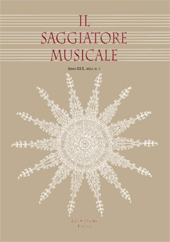2023 - Leo S. Olschki
Artikel
Digital Version
Herunterladen | Kopieren/Einfügen | kein Drucken
'Saul', «ossia la 'Semiramide' vestita di sacri concetti» : un "contrafactum" rossiniano per l'Oratorio della Vallicella (1834)
P. 53-74
- Saul, an oratorio written by Felice Visconti with music entirely borrowed from Gioachino Rossini's Semiramide, was given in Rome, at the Oratorio dei Filippini, in Lent 1834. The plot is taken both from the Holy Bible (1 Samuel) and from Vittorio Alfieri's tragedy Saul. However, it also displays some dramatic similarities with the legend of Semiramis, as elaborated by Voltaire and reworked in Gaetano Rossi's libretto for Rossini. One of the main similarities concerns the characters of Assur and Saul. For example, Saul focuses on the King's madness. The episode is narrated both in the Holy Bible and in Alfieri, but it also clearly recalls Assur's delirium in Semiramide (Act 2). The story of King Saul, who disavowed the God of Israel and was defeated by David (who was in turn destined by divine will to become King), could also be read as a precise political message in the turbulent decades of post-Napoleonic Rome.
- The musical sources of Saul, preserved at the Archivio dell'Oratorio dei Filippini, include an incomplete set of orchestral parts and only one vocal short score (particella). These sources allow us to verify which parts of Semiramide were reused into Saul, and also to put forward some hypotheses on the vocal cast of Saul's premiere. The transformation of an opera into an oratorio shows a remarkably close but wholly accepted proximity between the two genres; it also highlights new aspects of early 19th-century sacred musical production. [Publisher's text]
-
Informationen
DOI: 10.1400/296373
ISSN: 2035-6706
-
In derselben Datei
- Al lettore
- Giuseppe Torelli e le musiche oboistiche per la Cappella Musicale di San Petronio
- "As the Celebrated Author Conceived It" : Ferdinand Hérold's 'Zampa' in Nineteenth-Century Italy
- 'Saul', «ossia la 'Semiramide' vestita di sacri concetti» : un "contrafactum" rossiniano per l'Oratorio della Vallicella (1834)
- Su di un liuto nordafricano conservato nel Museo Preistorico Etnografico "Luigi Pigorini"


